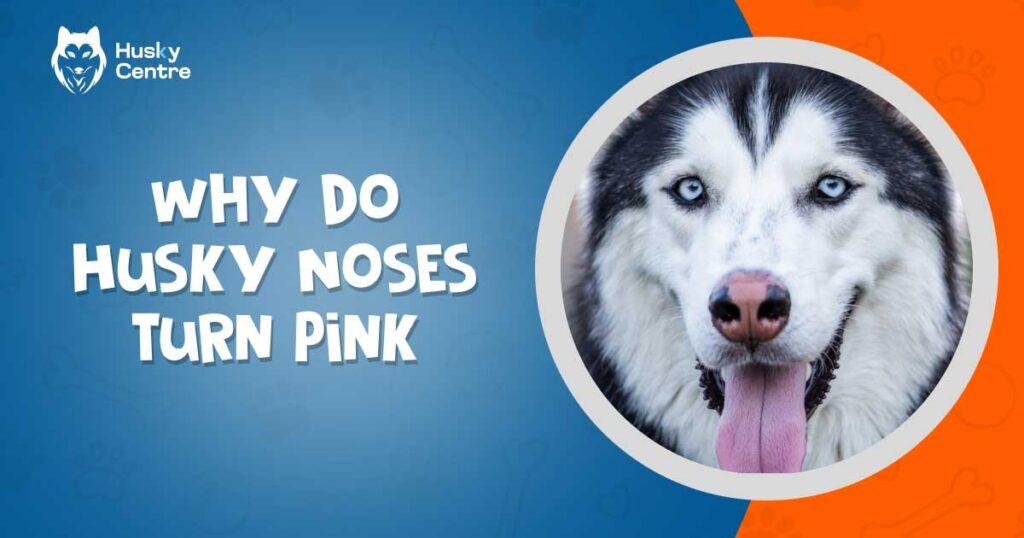Husky noses turn pink due to a condition called “snow nose” or “winter nose.” This usually happens during colder months.
Snow nose affects many Husky owners, causing curiosity and concern. The condition is generally harmless and temporary. It occurs when a dog’s nose loses pigment, often due to decreased sunlight. This seasonal change is more noticeable in winter but can happen anytime.
Understanding the reasons behind snow nose helps alleviate worries. Knowing it’s common and non-threatening reassures pet owners. Regular monitoring of your Husky’s nose color can help track changes. If the pink nose persists, consult a vet. Ensuring your Husky gets enough sunlight and proper care can help maintain its nose color.
Causes Of Nose Color Change In Huskies
Husky noses are known for their striking black color, but sometimes they turn pink. This color change can puzzle many dog owners. Various factors can cause this phenomenon. Let’s explore the primary causes of nose color change in Huskies.
Snow Nose
One common reason for a nose color change in dogs, especially Huskies, is snow nose. This condition, also known as “winter nose,” causes the nose to turn pink or light brown during the colder months. The exact cause is not entirely understood, but it is believed to be related to reduced sunlight exposure.
Key characteristics of snow nose:
- Appears in winter and fades in summer
- More common in northern dog breeds
- Temporary and harmless
Snow nose in Huskies typically resolves on its own as the seasons change. If your dog’s nose returns to its normal color in the warmer months, snow nose is the likely cause.
Aging
Aging is another factor that can lead to a nose color change in Huskies. As dogs grow older, their pigmentation can fade, causing their noses to turn pink or light brown.
Signs of aging-related nose color change:
- Gradual color change over time
- Accompanied by other signs of aging (e.g., gray fur)
- Permanent change
Older dogs may experience nose color changes along with other aging signs. This is a natural part of the aging process and usually does not require any treatment.
Health Conditions
Some health conditions can cause dog nose color change reasons. Infections, allergies, and autoimmune diseases can lead to changes in nose color.
Common health conditions affecting nose color:
| Condition | Symptoms |
| Infections | Swelling, redness, discharge |
| Allergies | Itching, redness, sneezing |
| Autoimmune diseases | Ulcers, crusting, color change |
If your Husky’s nose changes color and shows other symptoms, consult a vet. Early diagnosis can help manage these conditions effectively.
Genetic Factors
Genetics play a significant role in the nose color change in dogs. Some Huskies inherit genes that affect pigmentation. This genetic predisposition can cause their noses to turn pink.
Genetic factors to consider:
- Inherited from parents
- Permanent color change
- Does not affect health
If your Husky has a pink nose and no other symptoms, it might be due to genetic factors. This type of color change is typically harmless and does not require intervention.
Is A Pink Nose A Health Concern For Huskies?
Have you ever noticed a husky’s nose turning pink? You might wonder, is a pink nose a health concern for huskies? Huskies often experience changes in their nose color, which can lead to various questions among pet owners. Some changes are normal, while others might indicate health problems. Understanding these differences can help you ensure your husky’s well-being.
When A Pink Nose Is Normal
A pink nose in huskies can be completely normal due to several factors. Here are some common reasons:
- Seasonal changes: Huskies can develop a condition known as “snow nose” or “winter nose,” where their nose turns pink during colder months. This is typically harmless and common among huskies.
- Aging: As huskies grow older, their noses might change color naturally. This gradual change is usually not a cause for concern.
- Genetics: Some huskies are genetically predisposed to having lighter noses. If your husky has always had a pinkish nose, it might just be part of their genetic makeup.
In these cases, the pink nose is a normal part of your husky’s life. No immediate health concerns for dog nose color changes are present here.
When It Might Indicate An Issue
While a pink nose can be normal, sometimes it signals husky health issues. Here are some scenarios when a pink nose might be a concern:
- Sunburn: Huskies with lighter noses are more prone to sunburn. If the nose appears pink and is accompanied by peeling or discomfort, consult your vet.
- Allergies: Environmental or food allergies can cause the nose to change color and texture. Watch for other signs like itching or redness.
- Infections: Bacterial or fungal infections might cause the nose to turn pink and appear inflamed. Seek veterinary advice if you notice these symptoms.
Being aware of these signs and consulting your vet can help address any vet concerns for nose changes promptly.
Swelling, Sores, Or Crusting
If your husky’s pink nose is accompanied by other symptoms, it might indicate more serious issues. Look out for:
- Swelling: Swelling on the nose can indicate an infection or allergic reaction.
- Sores: Open sores or lesions can be a sign of underlying health issues or trauma.
- Crusting: Crusting around the nose might point to infections or autoimmune diseases.
Here is a quick table to summarize these signs:
| Symptom | Possible Cause |
| Swelling | Infection, Allergy |
| Sores | Health Issues, Trauma |
| Crusting | Infections, Autoimmune Disease |
These symptoms indicate potential health concerns for dog nose. Always consult a vet if you notice any of these signs. Early detection and treatment can prevent more severe problems and ensure your husky stays healthy and happy.
Tips For Caring For A Husky With A Pink Nose
Husky noses can turn pink due to various reasons, including genetics, weather changes, and health conditions. Pink noses may require extra care to prevent issues like sunburn or dryness. Here are some essential tips for caring for a Husky with a pink nose.
Protecting A Light-colored Nose
A pink nose is more sensitive to the sun. Sun protection for dogs is crucial, especially for Huskies with light-colored noses. Here are some steps to ensure your pet’s nose stays healthy:
- Use pet-safe sunscreen: Apply a sunscreen designed for dogs to your Husky’s nose before going outside. Avoid using human sunscreen as it may contain harmful ingredients.
- Provide shade: Ensure your Husky has access to shaded areas during sunny days. This prevents sunburn and reduces the risk of overheating.
- Limit sun exposure: Try to keep your Husky indoors during peak sun hours, typically between 10 AM and 4 PM.
- Protective gear: Consider using a pet hat or visor to shield your Husky’s nose from direct sunlight.
| Protection Method | Description |
| Pet-safe sunscreen | Specially formulated sunscreens for dogs to prevent sunburn. |
| Provide shade | Ensure access to shaded areas during sunny days. |
| Limit sun exposure | Keep your Husky indoors during peak sun hours. |
| Protective gear | Use pet hats or visors to shield the nose from the sun. |
How To Maintain A Healthy Nose
Maintaining a healthy nose involves regular care and monitoring. Here are some pet care tips for ensuring your Husky’s nose stays in top shape:
- Keep it clean: Wipe your Husky’s nose with a damp cloth to remove dirt and debris. This prevents infections and keeps the nose moist.
- Hydrate: Ensure your Husky drinks plenty of water. Proper hydration helps keep the skin, including the nose, moisturized.
- Moisturize: Apply a pet-safe nose balm to prevent dryness and cracking. Choose balms with natural ingredients to avoid irritation.
- Monitor for changes: Regularly check your Husky’s nose for any changes in color, texture, or moisture. Early detection of issues can prevent serious problems.
Here’s a simple routine for caring for a dog nose:
| Step | Action |
| 1 | Wipe the nose with a damp cloth daily. |
| 2 | Ensure adequate water intake. |
| 3 | Apply nose balm as needed. |
| 4 | Check for any changes regularly. |
By following these tips, you can ensure proper Husky skin protection and maintain a healthy, happy pet.
Frequently Asked Questions
Why Do Husky Noses Change Color?
Husky noses change color due to various reasons like seasonal changes, aging, or genetic factors. This is common and usually harmless.
Is A Pink Nose In Huskies A Health Concern?
A pink nose in huskies is generally not a health concern. However, if accompanied by other symptoms, consult a vet.
Can Weather Affect A Husky’s Nose Color?
Yes, weather can affect a husky’s nose color. Cold weather may cause their noses to turn pink temporarily.
Do All Huskies Develop Pink Noses?
Not all huskies develop pink noses. Nose color can vary widely among individual huskies based on genetics and environment.
Conclusion
Understanding why husky noses turn pink helps owners care for their pets better. Pigment changes can be seasonal or health-related. Always consult a vet for sudden or unusual color changes. Proper care ensures your husky stays happy and healthy. Embrace these unique traits and enjoy your beautiful, loving companion.


Meet Jarred, the heart and soul behind HukyCentre. With a deep affection for furry friends, he pours his passion into every word he writes. His genuine love for dogs shines through in his engaging and informative content. As a dedicated dog enthusiast, Jarred’s goal is to share valuable insights and tips that resonate with fellow dog lovers. Join Jarred on the journey as he celebrates the joy and companionship that dogs bring into our lives.



